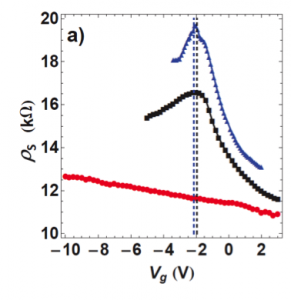Graphene field effect devices
We investigate possible applications of 2 dimensional materials (such as graphene, MoS2) in superconducting quantum devices. For example, graphene monolayers provide and alternative mean to create Josephson junctions[1], the fundamental constituents of superconducting qubits. Josephson junctions based on graphene have the advantage that their critical current can be modulated, providing a know for qubit tunability.
We fabricated graphene based field effect transistors where the monolayer graphene is suspended above a local metallic gate placed in a trench[2].Measurements at temperatures 77 K and below showed that the resistivity of the graphene is modulated by a voltage applied to the gate electrode(see fig. 2). This effect can be used to modify the properties of superconductor-graphene-superconductor junctions. This approach will enable new experiments such as graphene based superconducting qubits and nano-electromechanical resonators.
Figure 1: a) Isometric cartoon picture of a device (not to scale): A superconductor (gray) –Graphene (honeycomb)-Superconductor (gray) junction is suspended over a local metallic gate electrode (yellow). b) A SEM top view image of the graphene layer on the trench
Figure 2: Resistivity of the Superconductor-Graphene-Superconductor junction varies with the applied gate voltage at 77K (black) and 4K (blue). Dashed lines indicate the peak values of resistivity for respective temperature.
[1]: Heersche, Hubert B., et al. “Bipolar supercurrent in graphene.” Nature 446.7131 (2007): 56-59.
[2]: Ong, Florian R., et al. “Suspended graphene devices with local gate control on an insulating substrate.” arXiv preprint arXiv:1503.04147 (2015).


